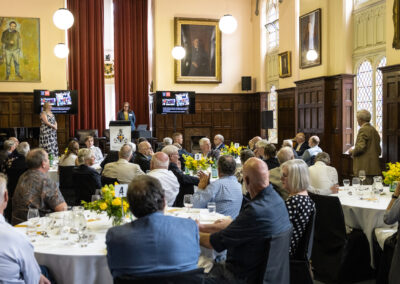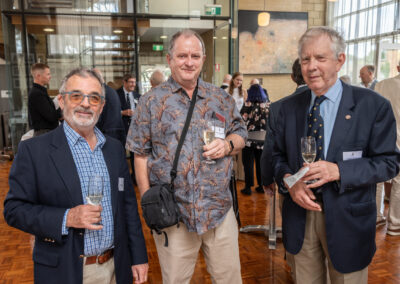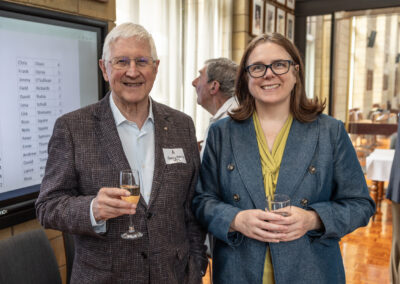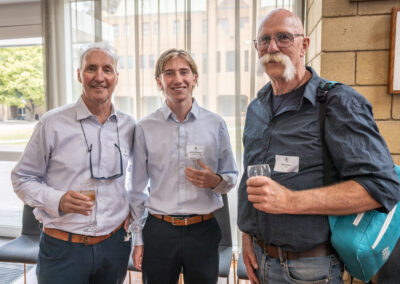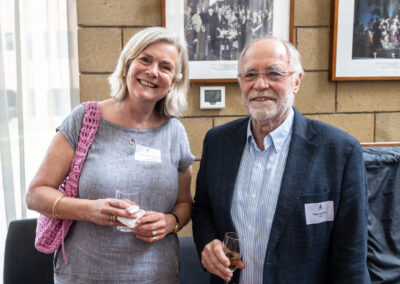Life, the Universe and Everything
Wyverns at the 50 years and beyond gathering were treated to a fascinating talk by Professor Virginia Kilborn (Wyvern 1993, left in photo), the inaugural Chief Scientist and a radio astronomer with the Centre for Astrophysics and Supercomputing at Swinburne University.
Virginia grew up in Ballarat and came to the University of Melbourne to study a Bachelor of Science, majoring in physics. Her plan to be a nuclear physicist took an unexpected turn in her first year of study.
“I found out that astronomy was a job- who knew that? I talked to the head of astronomy, Professor Rachel Webster and she said ‘Oh Virginia we are building a new instrument for the Parkes radio telescope, it will be ready in four years, you are in first year so that’s about the right timing. If you’d like to do a PhD, you need to get this grade, do this subject, then come back and see me in four years.’ So, I actually did that.”
Professor Kilborn is the first Chief Scientist in the university sector in Australia.
“It’s a really interesting role because I get to talk a lot with industry, I’m working with our students, with government on policy and STEM (Science, Technology, Engineering and Mathematics) education, helping to support that research journey across the university. It’s a role I’d really love to see in other universities. We can play a part in advocacy for science-based education and outreach, especially with all of the challenges around the world at the moment, particularly in climate change. We really need those voices out in the community, helping decision makers make decisions that are scientifically sound. One of the things I love about this role is being able to get out in the community and talk about science.”
And the audience loved hearing about science and the importance of astronomy in shaping our world.
“What I’m interested in is radio waves. Studying this looks at the universe as a whole, we are thinking where did we come from and where are we going, it puts our life in context, our position within the solar system, the universe. In terms of the impact of astronomy in Australia, we have been a leader in this field for at least 90 years. We were a big proponent of radio astronomy from the very first days. So much has come out of astronomy- engineering; the radio physics lab developed Wi-Fi, we’ve had very big leaps in super computing and AI and now when we think about optical there’s all the related technologies that have come out of trying to do the hardest thing, find a galaxy across the other side of the universe. It means you need the best equipment and that is directly translatable to the space industry and their technologies.”
The sky is the limit when it comes to the uses of an education in astronomy.
“The education and inspiration that comes from studying astronomy; it has trained a lot of people in the STEM area who have gone on to be leaders throughout Australia. Countless astronomers have gone on to be big in the banking sector, AI, teaching, because they have a deep education in the fundamental sciences.”
Professor Kilborn is a strong advocate for gender equality in STEM fields.
“The university sector is working hard to improve gender equity, particularly in leadership roles and in the STEM fields. The Science in Australia Gender Equity (SAGE) program is measuring progress, and assisting universities in making systematic change to improve gender equity. Personally, I’ve been involved in setting up a university-wide mentoring and development program for women at Swinburne called the Swinburne Women’s Academic Network (SWAN), which has helped dozens of women in their careers and promotion journeys. This has led to the WATTLE women in leadership program, which has been adopted by nearly half of the university sector and has over 200 women alumni. Continued efforts in gender equity are needed to make sure we harness the full potential of the workforce, and provide equity of opportunity for the leaders of the future.”

